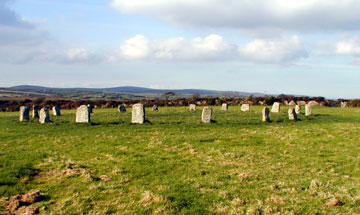I had the opportunity in 2001 to take advantage of the cheap air fares and visit Cornwall, in the southwest corner of England. I spent a couple of days at the Eden Project, a massive series of high-tech biospheres. I also got a chance to take a teacher-training in Ashtanga Yoga with David Swenson which was great. Any free time I came up with saw me tramping around the countryside visiting ancient sites from the late stone, bronze, and iron ages. These sites seem to be all over the countryside.
The oldest of these are stone megaliths called "cromlechs", or "quoits". The earliest of these were constructed around 4000 BC, but they continued to be erected over a 2000 year period. Some of the Older quoits appear to have been used for a thousand years as Bronze age pottery (about 2000 BC onward) and remains have been found in them.
These quoits are described by Ian McNeal Cooke in his excellent book, Journey to the Stones (ISBN 0-9512371-7-9). "The earliest chambered barrows - cromlechs - consist basically of a mound or enclosed area, usually circular, within which some kind of large stone construction forms a chamber with access via a short unroofed passageway through the barrow." Below are a couple views of Lanyon quoit.


These structures continue to be used by to this day and one can find candles and other materials inside them. They are often located in locations that give them excellent views of the surrounding countryside. There is sometimes an eerie sensation associated with these ancient sites. I spent some time inside the Chum quoit seen below. It was very quiet inside till I started hearing a very deep rumbling sound. I crawled outside and could barely hear a tractor working a field in the distance, the location and construction of the quoit seemed to greatly magnify the sound of the tractor.


About 2500 BC a series of stone circles started appearing throughout present-day England. Over 900 such circles are still present in varying states of preservation. A number of excellent examples of these stone circles are to be found in the Lands End peninsula of Cornwall.


The Boscawen-un Stone Circle above is an example of a circle with a large central stone.


The Merry Maidens stone circle shown above is right next to the roadway and gets lots of visitors.


Above is a fairly unclear view of a circle called the "Nine Maidens" that has a central stone. There are actually more than nine stones that make up the ring of stones of this circle. In addition to the more ancient quoits and circles, there are a number of more recent structures. One such is the Carn Euny settlement which includes a long tunnel called a "Fogous".


Carn Euny Fogous Remains of Carn Euny Settlement
Another group of relics from the Bronze Age (about 1500 BC) are holed stones. Rituals have been associated with these stones for thousands of years. Below is one of the more famous found near Madron in Cornwall and is called the "Men-an-Tol" stone (from the Cornish maen = stone and tol = hole). One description of more current rituals with this stone was provided by Courtney in his Cornish Feasts and Folklore (1890, Penzance) as follows:
"There are many holed stones in the Country. The one at Mandron is sometimes called the crick stone. It gets this name because in days not very long ago people afflicted with rheumatism, sciatica, etc. in May, and at certain other seasons of the year, crawled on all fours nine times around these Men-an-tol from the east the west , and, if thin enough, squeezed themselves through the aperture. This was then thought such a sovereign remedy for these diseases that parents brought their weak-backed children and carried them around."
